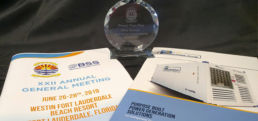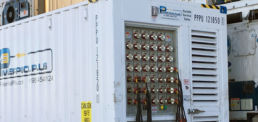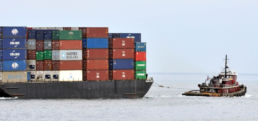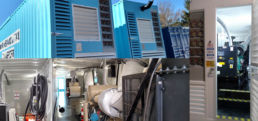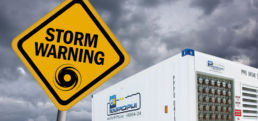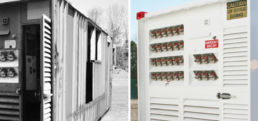Power Pool Plus receives Silver Sponsor Awared at 2019 PMAC Conference
Power Pool Plus was an honored recipient of the Silver Sponsor Award at this year’s 2019 Annual General Meeting of the Port Management Association of the Caribbean (PMAC), held at the Westin Resort in Fort Lauderdale, Florida from June 26th – 28th, 2019.
The mission of PMAC is "To foster operational growth and financial efficiency, and to enhance the level of service to the mutual benefit of Caribbean Ports and their stakeholders through the sharing of experience, training, information and ideas." This, their 22nd annual event, featured a number of noteable stats; first time held in the USA, highest particiapation at 17 of 18 member ports, and one of the largest attended meetings to date.
Attendees and speakers from around the Caribbean Basin and points around the globe shared insight on the digitalization of the port environment, predictive analysis of port equipment to mitigate machinery downtime, the future of port modernization, and a topic critical to the needs of Caribbean port operators, discussing current regional initiatives in disaster relief and logistics. The latter topic remained of high importance due to the nature of island relief as island ports being the only conduit to receive such aid.
Presenting to the group, Ted Shelson, Marketing Director/Power Pool Plus, provided a general overview to the delegation of our Purpose Built Power Generation Solutions and how they can be uniquely configured to meet the individual needs of every port customer whether for reefer, ground power, or a specialized combination of the two.
Power Pool Plus
Purpose Built Power Generation Solutions
Learn more at:
www.powerpoolplus.com
www.pmac-ports.com
How load affects Power Pack performance
Proper Loading of Power Pack Reefer Generators
Are your reefer loading processes harming your power packs?
In a recent survey we asked the question, ‘What is your typical practice for connecting reefer plugs to your power pack?’ Possible choices included:
- We fill the receptacle panel then start the power pack.
- We connect one at a time while the power pack is running.
- We connect them in groups of 5 or more at a time.
While the number of responses varied between the choices, a significant number selected choice #1, indicating that loading the power pack’s receptacle panel with connections prior to generator start is the preferred choice.
It’s easy to understand, perishable cargo tends to move in large quantities. And with many reefers hitting the docks at any one time, the goal, of course, is to quickly get these refrigerated containers connected to power. But take a moment to consider that this technique may have the potential to cause damage to your equipment which could potentially render your cargo without any electrical power.
Why this is bad.
Loading too many reefer boxes at one time on a power pack can cause the engine to work excessively hard to catch up to the required load. In the meantime, this may result in a drop in generator performance as the engine struggles to maintain sufficient power to meet this sudden demand. The results will be a reduction in hertz or electrical frequency causing potential damage to the generator’s voltage regulator. Loss of frequency can flow downstream to the reefer causing damage to refrigeration compressors. Additionally, there is added stress on the fuel delivery system to maintain engine power.
Either of these scenarios will leave you with a down machine, expensive repairs, and a load of perishable cargo without electrical power to maintain temperature.
How to avoid a problem
A systematic approach to loading Power Packs should be incorporated in order to avoid costly and time delaying damage.
Power Pack Loading Procedure, a Best Practice Approach
Every power pack is different and may have varying engine and generator configurations. It is strongly advised to review and understand all of the manufacturer’s operations manuals prior to beginning any power pack starting procedure.
Once started, here are some guidelines to ensure that you maintain the best performance from your power pack generator.
Applying load
Once power pack is properly started allow the engine to warm up for 5 minutes before loading reefers. Engage Main Breaker to ON Position.
For ESL Power receptacle panels:
- Insert a single reefer plug into the panel and secure locking ring by rotating clockwise
- Depress the plunger to energize receptacle.
- Repeat steps 1 and 2 above for each additional receptacle plug added to the panel.
Continue loading reefers until reaching a load of 50%. At this time, check amperage on the generator control panel. This is important to ensure that your generator is managing the load and working within optimal engine performance. Refer to the specifications of your power pack for total amperage information.
If at 50% capacity total amperage is under the specified maximum amperage of your power pack, then continue to load reefers gradually to full capacity, but continue to monitor the ammeter.
If amperage is OVER the maximum amperage STOP LOADING and wait for refrigerated container compressors to cycle before continuing to load more.
Loading too many reefers, especially hot reefers, at any one time may cause the amperage draw to exceed the limitations of your power pack.
Maximum amperages vary depending on the specifications of your power pack. If you are unclear on the maximum amps for your power pack, contact Power Pool Plus for information. Operating a power pack at near max amp rating should be monitored closely to avoid tripping main circuit breaker and losing all connected reefers.
A special note on loading: At minimum, there should always be at least a load of 25% of total panel capacity. In other words, if operating a 40 plug power pack, minimum load will be 10 reefers or 8 for a 30 plug machine. This will protect your power pack in 2 ways:
- Avoid the damaging effects of wetstacking – thick black exhaust smoke.
- Allow a more efficient use of your power pack. More reefers attached to your power pack means less fuel burn per reefer – which will save you money.
Unexpected shut down while connected to full load of reefers
Should an unexpected engine shut down occur, either through a run-fault event or manual stop, never perform a re-start while connect to a full load of refrigerated containers. Instead, load should be removed from the power pack and brought back on gradually. Best practice would be; de-energize ALL ESL receptacles, ensure that the main breaker is CLOSED, and re-start the power pack. At this time bring reefers back on line following the procedure highlighted above by energizing the ESL receptacles individually until all are successfully back online.
Manually shutting down an operating Power Pack
Often times, out of convenience, bad habits, or simply insufficient operator instruction, emergency stop (E-stop) buttons are routinely used to shut down a running power pack.
Emergency stop buttons should only be used for emergency situations, such as pending harm to personnel or equipment.
Using E-stop buttons as a regular means of power pack shut down can cause damage to the engine and generator components by not allowing a proper disconnection of electrical current to the load and necessary slow cool down of the engine.
Instead, follow this procedure,
- Open main generator circuit breaker
- Allow engine to cool down for 10 minutes
- Press the stop button located on the generator control panel. The generator will then stop. Some power packs have a built in shut down procedure that initiates upon pressing the stop button on the Control Panel. Check your Owner’s manual for specific information on your power pack design characteristics.
In short, unless it is an actual emergency, use the stop button located on the Control Panel and NOT the Emergency Stop buttons.
Wrapping it up
Each Power Pack is different with unique engine kVA and kW output. But the process for loading them to protect the Power Pack from overloading is the same. Following these quick and easy steps will ensure long lasting performance from your reefer power solution.
Power Pack maintenance doesn’t begin and end with oil changes. It starts with proper machine operation. No matter if your operation handles chilled loads, frozen loads, or pre-trips hot reefer boxes, Power Pack performance can be greatly affected by the way in which load is applied. Following these procedures to ensure that you get the most out of your reefer power system.
For more details on power pack operations read: 7 Best Practices for Every Power Pack Operator.
Have questions?
Please contact us today to learn more.
How to Avoid Port Congestion?
Photo Credits: Michael Neelon/Alamy; Columbia Group
Recent port expansion projects around the world are a sign of the competitiveness to attract some of the newest and biggest container ships. What has been slower to keep pace is the supporting infrastructure in surrounding areas. Roadways leading in and out of terminal gates are creating truck traffic gridlock at many ports. Sensitive refrigerated cargo is at risk if not moved quickly.
As more and more port operators are turning to alternative methods for moving their cargo off terminal, barge service has become much more viable. Utilizing existing waterways, barges offer the ability to bypass this congestion by moving cargo from the main port to areas more easily accessible to trucking and rail.
This is especially important for refrigerated cargo where timing is critical.
Yet moving reefer by unmanned and unpowered barge can present a host of challenges for the reefer cargo operator.
Power challenges for the barge operator
- Conformity of reefer diesel generators, or power packs, to the business of container handling. The greater its design fits into the regular operation the faster barge loading and unloading can occur.
- Long transit times without the ability to refuel can present a major barrier to the barge operator.
- Limited space; tightly packed containers on barges leave little room for diesel powered generators to breathe.
- Proximity to salt air and water environments, especially during heavy seas, can be problematic for mechanical equipment.
- Generator failure while in transit is a recognized concern to maintaining operational success for the reefer barge operator.
Power Pool Plus has been addressing these challenges for nearly 30 years by engineering and building power pack designs that are Purpose Built to deliver a reliable and continuous reefer power supply over multiple days of unmanned overseas transit.
What Does it Mean to be Purpose-Built?
If you’re in the business of handling refrigerated cargo, then you know all too well about the constant reliance on electrical power to keep your perishable cargo fresh (at least while it's under your watch). The need for generators to supply this electric power is great.
Using standby generators that are designed for emergency use may not be the best solution for managing the harsh realities of the reefer cargo industry.
What’s required is a purpose-built solution that can provide substantial electrical supply in a robust package that fits neatly into the working environment of the shipping industry.
But what does Purpose-Built mean?
 To be purpose-built a product must have the ability to complete a specific task so uniquely that every aspect of its design takes the following elements into account:
To be purpose-built a product must have the ability to complete a specific task so uniquely that every aspect of its design takes the following elements into account:
- How it is going to be used? (Application)
- Where it will be used? (Environment)
- Who will be using it? (Safety)
- When it will be used? (Time Frame)
Power Packs, generators designed for powering refrigerated containers, are an example of such a product. But not all power packs are created equal. Simply being called a Power Pack does not make it purpose-built for reefer cargo application.
Power Pool Plus takes all of the above elements into consideration when designing power packs.
How it will be used (Application)
 Our Power Packs are designed to be easily handled in and around a port environment including ships and barges. Outfitted with both fork pockets and corner pockets our power packs can be easily moved or positioned by any heavy lift port equipment.
Our Power Packs are designed to be easily handled in and around a port environment including ships and barges. Outfitted with both fork pockets and corner pockets our power packs can be easily moved or positioned by any heavy lift port equipment.
For use on a barge, space is limited. Yet maintaining proper airflow is critical to power pack performance. We take that into consideration while still allowing our machines to stack neatly between containers.
Where it will be used (Environment)
 Uneven ground, constant repositioning, salt air/water, extreme heat and humidity, cold arctic waters – these are just some of the harsh realities of keeping the cold chain intact. Our power packs are designed and built with these considerations.
Uneven ground, constant repositioning, salt air/water, extreme heat and humidity, cold arctic waters – these are just some of the harsh realities of keeping the cold chain intact. Our power packs are designed and built with these considerations.
Who will be using it (Safety)
 In ports things move fast and keeping people safe is priority #1. Power Pool Plus goes to great lengths to ensure this is met.
In ports things move fast and keeping people safe is priority #1. Power Pool Plus goes to great lengths to ensure this is met.
To reduce the risk of electric shock, we use only ESL’s line of safety interlock receptacle modules. This ensures safe handling of electric plug connections made at the Power Pack panel.
When it will be used (Time Frame)
 How long will your power pack need to run unattended? Fuel delivery in ports can be a big problem. And on barges, it’s impossible until next port call. Our power packs are designed with standard 1000 gallon (3785l) fuel tanks ensuring long runtimes of 36 to 48 hours depending on use and application. Additionally, our on-board engine lubricant reserve tanks with automatic refilling are essential to avoid low oil engine shutdowns during unattended operation on sea or land.
How long will your power pack need to run unattended? Fuel delivery in ports can be a big problem. And on barges, it’s impossible until next port call. Our power packs are designed with standard 1000 gallon (3785l) fuel tanks ensuring long runtimes of 36 to 48 hours depending on use and application. Additionally, our on-board engine lubricant reserve tanks with automatic refilling are essential to avoid low oil engine shutdowns during unattended operation on sea or land.
Of course, these are just some of the standard purpose-built features that set Power Pool Plus apart.
Have a very unique requirement?
Our engineering team can design a purpose-built power pack specifically for you. Just let us know the details.
What’s in the Name? Power Pool Plus Defined
What does the name Power Pool Plus mean?
We are sometimes asked, “Do you install swimming pools?”
It happens; and NO, we don’t.
What we DO provide are the resources your operation needs for reefer power generation in large ports or small yards, on barges or ship decks, and from small mobile units to large standby generators.
Yet there's more meaning to our name that needs to be shared, as it tells the entire story of who we are and what we offer. Three words, Power Pool Plus, representing three ideals, and together providing one complete solution.
Here's how we define our name.
POWER
It's the operative word in our name, as in electrical power. We build, rent, and sell generators that are Purpose Built to the needs of the reefer operator. Our Power Pack generators are crafted and engineered to withstand some of the harshest environments in which our products may be the only dependable electrical power source.
Power Pool Plus offers complete power solutions for the port operator that include:
- Power Pack Generators
- Receptacle panels of any size
- Electrical cables
- Trailer Mounted Mobile Generators
- Standby and Emergency Generators
POOL
This word often gets people confused, but it's the one that really identifies the uniqueness in our ability to provide power solutions to the reefer terminal operator.
Let’s begin with the definition of the word as it appears in dictionary.com and merriam-webster.com.
- pool2 [pool] noun
- a combination of resources for common advantage.
- a readily available supply of people or objects
- pool2 [pool] verb
- to combine or contribute (as assets) in a common form or effort
Through the use of our collective inventory of products, industry relationships, and the adoption of this less common use of the word, is how Power Pool Plus has the means to POOL, or bring together, many resources to provide unique power generation solutions that maximize our customer’s operational efficiencies and financial bottom line.
PLUS
Something extra; over and above the norm.
PLUS refers to the many extra steps we take to support you through quality service and our nearly 30 years of professional experience serving the electrical power needs of the refrigerated transportation industry.
So there it is. Power Pool Plus. Three words carefully chosen when we started our business to clearly define our place in the refrigerated transportation industry.
Allow us to provide the POWER you need through our POOL of resources PLUS the support you deserve.
Weather Preparedness and Your Power Packs
No one knows with any certainty how this year's Hurricane Season will end up. The best we can do is plan and prepare. And each has its place.
Planning
When disaster does strike, ensuring that you have an uninterrupted supply of electrical power is essential. Understand what resources that are currently at your disposal is the first step. The power packs that you already employ for your reefer operation can also be effectively used to provide emergency electrical power to buildings*.
Preparing
Using your power packs for emergency building power means that maintenance can't wait. Many tropical storms provide little advance warning. So keeping them in top shape and ready to run 24/7 is essential. Putting off required preventative maintenance on your generators may result in an unexpected failure.
* Safety is paramount. Please refer to your local electrical experts before connecting any generator to a building's load.
How to Transport a Power Pack Reefer Generator. Yes, There is a Wrong Way.
Is there a wrong way to transport a Power Pack?
Power Packs by their very nature are mobile machines. Built within a modified shipping container they easily assimilate into any port environment for powering refrigerated cargo - large yet easily managed by high capacity forklifts or loaded container handlers.
Power packs can be transported over-the-road by truck, either on a chassis or placed on a step-deck trailer.
But did you know, there is a right and wrong way to transport them over land?
Knowing the correct answer could prevent an expensive repair.
The Wrong Way

The RIGHT Way

Why is this important?
 Loading a Power Pack with the exhaust end facing into the wind may cause forced air to enter the exhaust system and spin the turbo. While turbo bearings are designed to spin, they also need proper lubrication which only occurs during engine operation when the oil pump can supply sufficient oil to the turbo bearings.
Loading a Power Pack with the exhaust end facing into the wind may cause forced air to enter the exhaust system and spin the turbo. While turbo bearings are designed to spin, they also need proper lubrication which only occurs during engine operation when the oil pump can supply sufficient oil to the turbo bearings.
To prevent a possible turbo failure and thousands of dollars in unnecessary repairs, Power Pool Plus recommends loading power packs for transport with the exhaust end facing toward the rear of the trailer.
Power Pool Plus, the leader in power pack design and function since 1990.
Finding New Life in Worn out Power Packs
Power packs are used in some of the harshest environments and exposed to some of the toughest elements - tropical heat, salt water, freezing temperatures, and more. There eventually comes a time when even the best maintained machines need to be replaced.
Re-Manufacturing
A Cost Saving Solution
With the right evaluation and attention to detail, your existing power pack may be re-manufactured to like-new condition at a cost that's far less than purchasing new.
Our team has the ability to re-manufacture tired, worn, or damaged power packs of any make or model.
From blown engines and failed generators to damaged receptacle panels and crushed containers, we will work within your budget requirements to re-build your existing unit to save you both time and money.
How do we do it? - Watch our video
Learn how Power Pool Plus can help turn your aging fleet of power packs back into like new condition – inside and out.

